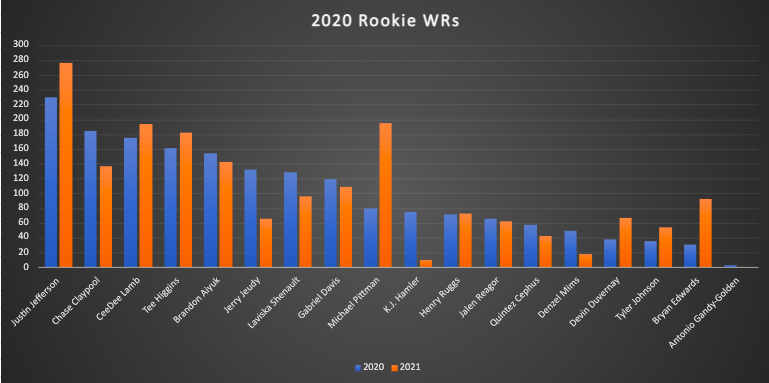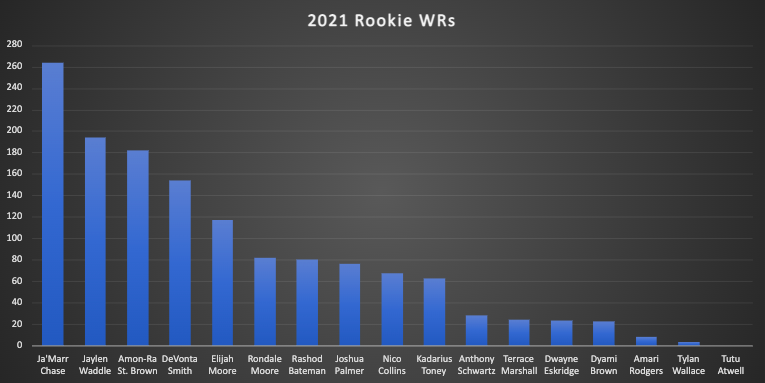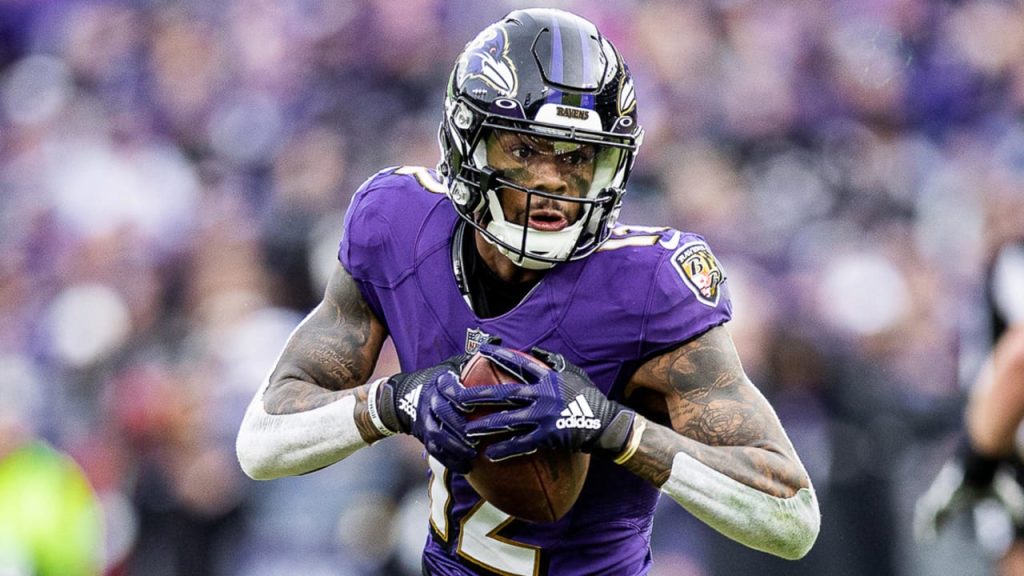Last February, I wrote an article called Selling Reagor, Ruggs Potentially Best Course of Action. The article had a series of data sets that created a bar for rookie wide receiver efficiency. I tried using this as a predictor of their career success.
The article’s conclusion listed Philadelphia Eagles WR Jalen Reagor, Las Vegas Raiders WR Henry Ruggs, and Indianapolis Colts WR Michael Pittman Jr. as three wide receivers you wanted to get out away from.
Seeing that Pittman was included, you may already be ignoring this analysis. But I believe there is still some legitimacy to this data.
Now, I plan to dive further into what I discussed last year. It’s time to re-evaluate the previous data and predictions and use this to predict what wide receivers from the 2021 class you want to hang onto and which you may want to move while they still have value.
Spoiler alert: Rashod Bateman owners will want to read further.
Setting the Guideline
In last year’s piece, the guideline to analyze a wide receiver was that they needed to reach 80 fantasy points in 0.5 PPR scoring formats to be considered a safe hold in their rookie season.
That’s a fairy low-bar that showed there was already production from the player in their first year in the league. However, they didn’t need to be a WR1 or WR2 already to be considered someone worth keeping.
The wide receivers needed to average at least five points over 16 weeks in their rookie year. Injuries, suspensions, and any other outside factors are still included. It’s simple a WR just needed 80 points or more their rookie year, no matter the circumstances.

Reviewing the 2019 Rookie Wide Receiver Class
Evidence over past seasons showed this 80-point threshold was predicting a quality fantasy asset at about a 70% rate.
Past wide receiver data from 2015 through 2018 was easier to analyze and determine if this process was legitimate because we had multiple seasons from players to study.
Even the 2019 class had two seasons for us to look at when I wrote about this last year. Now, there are three seasons of data for that class:

Adding in the third year only reconfirms what we already proposed: Tennessee Titans WR A.J. Brown, Washington Football Team WR Terry McLaurin, San Francisco 49ers WR Deebo Samuel, Seattle Seahawks WR D.K. Metcalf, Pittsburgh Steelers WR Dionte Johnson, Baltimore Ravens WR Marquise Brown, and Kansas City Chiefs WR Mecole Hardman have continued to average 100 points or better in the seasons since their rookie year. Those who scored under 80 have still failed to produce even one 100-point season.
The players that didn’t hit 80 fantasy points may look like a bunch of uninteresting prospects in retrospect, but New England Patriots WR N’Keal Harry, Arizona Cardinals WR Andy Isabella, Colts WR Parris Campbell, Philadelphia Eagles WR J.J. Arcega Whiteside, and former Cardinals WR Hakeem Butler are all players that had a rookie draft ADP in rounds one and two.
In this sense, the threshold that was set from their rookie season was accurate and works.

Moving to the 2020 Draft Class
While 2019 still looks good, things change the following year. One glaring miss from the 2020 class will have any of this system’s critics yelling at me. And that’s Pittman.
When the season ended last year, Pittman sat at 78.9 points. That’s 1.1 points under the threshold that I had set.
He would have met the threshold and been another feather in the cap if he had had one more six-yard catch last season. However, that wasn’t the case.

Last year, I mentioned that Pittman only played in 13 games and dealt with the COVID-19 offseason, limiting rookies’ work in training camp. However, the whole point of this system is that it ignores any outside issues such as injury, suspensions, etc.
There were exceptions to the rule before, like Pittman. As I mentioned in last year’s article, Tampa Bay Buccaneers WR Chris Godwin and Los Angeles Chargers WR Mike Williams were receivers under the 80-point threshold their rookie year that have become assets with value.
The system was never perfect, but it does give us a firm guideline.

WR Finishes for the 2021 Draft Class
If you still believe there could be something to this madness, then you probably wonder who didn’t make the cut this year. Let’s take a look at the finishes for this year’s rookie WR class.

Cincinnati Bengals WR Ja’Marr Chase, Miami Dolphins WR Jaylen Waddle, Detroit Lions WR Amon-Ra St. Brown, Eagles WR DeVonta Smith, and New York Jets WR Elijah Moore easily finished above the 80-point threshold.
Cardinals WR Rondale Moore (82.1 points) and Ravens WR Rashod Bateman (80.5) just scraped over the threshold by the skin of their teeth.
Meanwhile, Chargers WR Joshua Palmer (76.4) barely missed the cut.
Moore and Bateman aren’t entirely safe, though. The NFL changed to a 17-game regular-season schedule this year. With the guideline previously set at 80, the threshold was an average of 5 points per week as a rookie.
With 17 regular-season games, this would mean a WR would need to reach 85 points to meet the threshold. Rondale Moore and Rashod Bateman didn’t make it this year with this adjustment.
Once again, this system doesn’t account for outside factors like injuries or suspensions.
Should you be worried about New York Giants WR Kadarius Toney and his 62.86 points kept him well under the bar? Or should you feel satisfied with his output because he missed seven games this season? That’s for each owner to decide.
The only thing I can say is there have been many wide receivers with lackluster rookie years that owners were still excited about in the past. These WRs were excused for injuries or other outside factors. And, for many prospects, it never panned out.
Similarly, guys like Pittman showed they are a great talent once they could get on the field for an entire year. Again, it’s for each owner to decide.
Breaking the Mold
Last year’s article listed 36 WRs from 2015-2018 that didn’t hit the 80-point threshold.
Of that list, only six averaged 100 points or more in the seasons after their rookie campaign: Godwin, Jacksonville Jaguars WR D.J. Chark, former Carolina Panthers WR Curtis Samuel, Williams, former Tennessee Titans WR Corey Davis, and former Eagles WR Nelson Agholor.
Adding their 2021 season, Samuel and Chark are now both averaging below 100 points in the seasons after their rookie year. There are now only 4 WRs from 2015-2018 that break the mold.
Adding the 2019 draft class, ten more wide receivers didn’t reach 80 points in their rookie season, and all of them have averaged under 100 points in the seasons after that.
If we add Pittman as someone who broke the mold in 2020, he’s the only one to make it past 100 points in his sophomore season out of the ten that didn’t make the 80-point threshold.
That would mean that since 2015, only 5 of the 56 rookies (Pittman, Godwin, Williams, Davis, and Agholor) who didn’t make it to 80 points their rookie season went on to average 100 points or more in their seasons after their rookie year.
That’s only 8.9% of WRs that have broken the mold.
Even amongst these five, the numbers are not overly exciting. From 2015-2020, a WR needed to score, on average, 141.71 points to be a top-36 WR or a WR3 in 12 team leagues.
Since his rookie year, Godwin has averaged better than a WR3 in all four seasons. However, Davis, Williams, and Agholor only had a WR3 or better season for a combined 6 of the 14 seasons they played.
Summary
So, are we to conclude that R. Moore and Bateman are players you should be looking to sell immediately? Honestly, it is up to each owner to decide.
No one can foresee the future for a wide receiver who had a less-than-stellar rookie year, just like we don’t know that Chase will be a WR1 for the next five years.
However, in dynasty, we are always playing the odds.
If this data tells us anything, the odds are not in favor of guys who aren’t producing right away.
While running backs, tight ends, and quarterbacks take some time to become premier fantasy assets, wide receivers show up on the scene right away. Holding onto a player who had a lackluster rookie season is absolutely in your right.
If you believe in the guy, then you should hang onto him. But be warned, the drop in value if they have a terrible sophomore campaign is drastic.
While I was mocked last year for even mentioning that Reagor may be worth selling while you were ahead, it looks a lot different a year later.
Looking at the Dynasty Nerds trade browser tool in DynastyGM, I can see several actual trades last summer that involved Reagor being traded for a 2022 or 2023 1st round pick.
The latest trades involving Reagor for picks only saw a third or fourth-round pick as the return.
Getting out while a player still has perceived value is always better, and we are at a crossroads already for guys like R. Moore, Bateman, and Toney.
As I concluded last year, this data is not the end-all-be-all of wide receiver predictions. However, there are exceptions to the rule. It’s folding early before all your chips are in on a bad hand. Recovering some value back and moving forward with something to work with.
Best of luck to those owners deciding which way they will go with some of these 2021 WRs.








